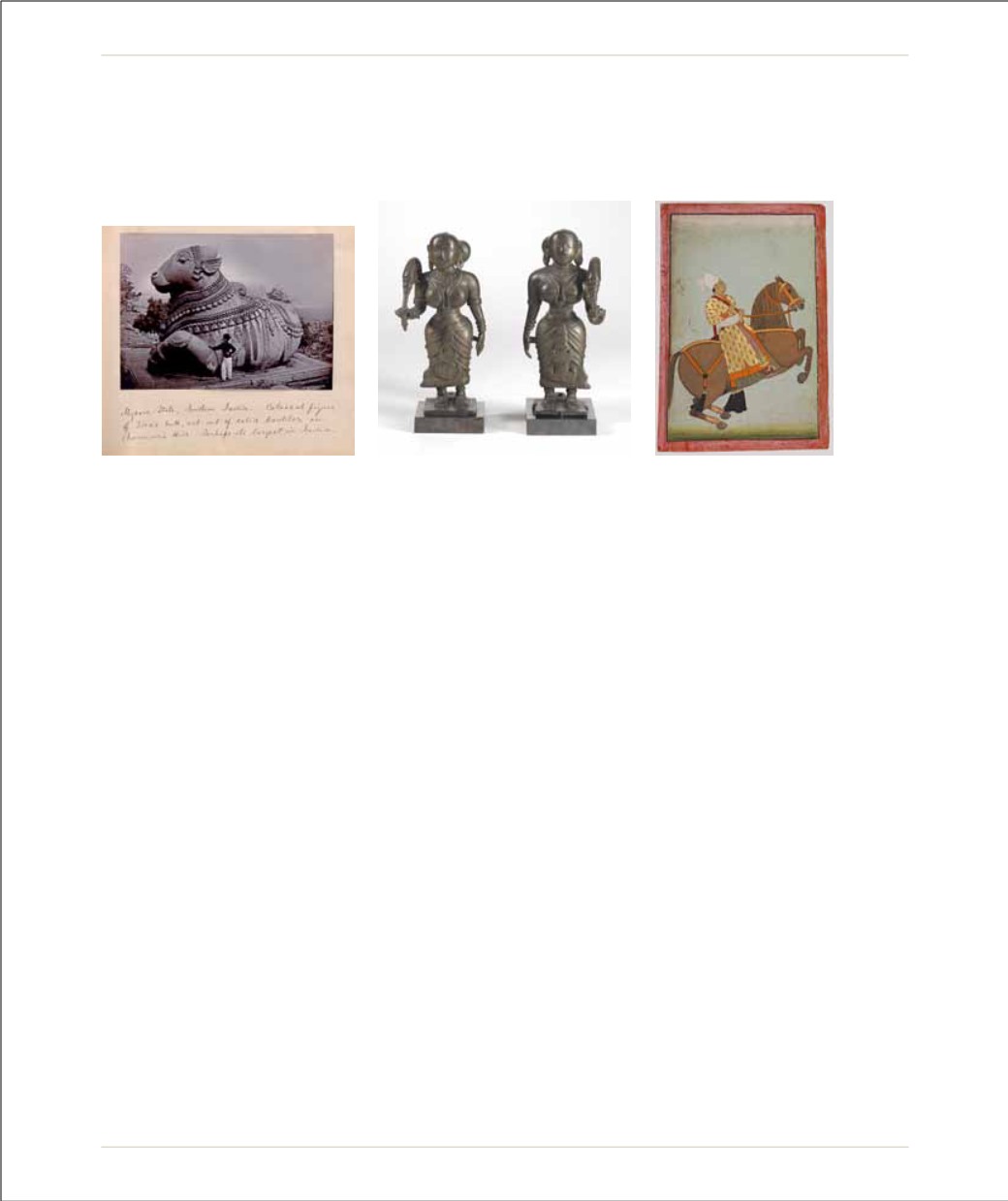
96
REWINd |
RELIVE |
Reveal
| RELATIONSHIPS | REmEmbER | REAdy
John Burke, del Tufo & Company, Philip
Adolphe Klier, Gw Lawrie, Thomas A
rust and unknown
Volume I, III, IV: Untitled
(
photographs
collected in India by a travelling theatre
group
) c.1880–1900
the acquisition of a personal collection of
three photographic travel albums builds
substantially on the gallery’s collection
of colonial asian photography. carefully
assembled and annotated by a member of
the williams family theatre group, which
toured india in 1899–1900, the albums
document the travels of two american
actors, Jean stewart brown and hannibal
williams. they cover a vast range of subjects,
including views of monuments and temple
sculptures (as in the image above, depicting
the stone carving of shiva’s bull nandi in
mysore); as well as portraits of labourers,
royalty, officials, holy men, and indian and
himalayan women. together, they provide
a rich document of india at the height of the
rule of the british raj.
John Burke
/ Photographer / fl. India 1857–97 / Ireland 1843–1900 /
Del Tufo & Company / Photographer / India a.c. Madras 1880–1910 /
Philip Adolphe Klier / Photographer / fl. Burma 1860–1900 / Germany
1845–1911 / GW Lawrie / Photographer / fl. India 1880–90s / Scotland
1881–1921 / Thomas A Rust / Photographer / fl. India 1880–89 /
England 1870s–1900 / Unknown / Photographer / Volume I, III, IV:
Untitled
(
photographscollected in Indiabya travelling theatregroup
)
(detail) c.1880–1900 / 187 albumen and gelatin silver / photographs,
bound in three albums / Image sizes: a) 20.9 x 27.9cm; b) 7.6 x 12.7cm;
c) 12.7 x 17.7cm (approx.) / Purchased 2011. Queensland Art Gallery
Foundation
unknown
Equestrian portrait of Rathor Udai Bhanji
c.1760–80
miniature painting is an important south
asian art tradition, and a number of major
schools and themes are represented in this
recent acquisition of nine watercolour-and-
ink works dating from the eighteenth and
early nineteenth centuries.
directly influenced by persian miniature
painting, the miniature tradition flourished in
sixteenth-century india under the rule of the
mughals. while mughal miniatures usually
depicted military conquests and scenes
from the royal courts, the rajput style,
which flourished in the courts of rajasthan
in the eighteenth century, incorporated
hindu imagery, lavish royal scenes,
romance and portraiture. the collection of
rajput works, from artistic centres such
as marwar and mewar, includes
Equestrian
portrait of Rathor Udai Bhanji
.
Unknown
/ India, Marwar /
EquestrianportraitofRathorUdaiBhanji
c.1760–80 / Opaque watercolour with gold / 32 x 21.5cm / Purchased
2011. Queensland Art Gallery Foundation.
unknown
Untitled
(
Chauri bearers
) 16th century
these bronzes are processional figures
from the indian state of orissa. taking
the form of
chauri
(fly-whisk) bearers,
the works are rare examples of figurative
sculpture from the period, created for
use in processional or ceremonial temple
rituals. ritual bronzes in a great variety of
forms and styles were essential features
of temples dedicated to gods in india. their
unrivalled elegance and beauty make them
hallmarks of india’s pre-modern sculptural
tradition, while the extent of their use
reflects the central roles they played in
social and religious life.
these works reflect how indian sculpture
drew on a range of influences, including
sacred texts and poetry, music, dance, the
natural world and cosmology, to inspire
worshippers of the hindu faith. they
were acquired with funds from the henry
and amanda bartlett trust through the
Queensland art gallery Foundation.
Unknown
/ India /
Untitled
(
Chauribearers
) / 16th century / Copper
alloy on metal veneer on wood / 29.8 x 15.5 x 10cm (base: 10 x 12cm);
30.5 x 15.5 x 13cm (base: 13 x 12cm) / Purchased 2011 with funds
from the Henry and Amanda Bartlett Trust through the Queensland
Art Gallery Foundation


